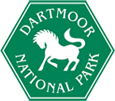Blanket Bog and Raised Bog
Blanket bog is the term given to the mantle of peat, at least half a metre thick, which covers the gentle slopes above 400m on the open moor. It covers the central parts of the two main moorland masses on Dartmoor centred on Cranmere Pool in the north and Naker’s Hill in the south. Dartmoor has about 8500 ha of blanket bog.
Raised bog, where the peat forms a dome, occurs at Tor Royal Bog and covers about 8 hectares. It is the only raised bog in Devon or Cornwall.
Both types of bog are internationally rare and are specially protected under the European Habitats Directive.
Characteristic plants are deer grass, hare’s tail cotton grass, cross-leaved heath, round-leaved sundew and bog asphodel as well as numerous bog mosses.
The key species associated with Dartmoor’s blanket bog are golden plover which breed here in small numbers and overwinter in much larger groups in a variety of moorland habitats. Dunlin also use blanket bogs for breeding. Crowberry is rare and found in a few places on the moor.
All the blanket bog areas are within the North Dartmoor or South Dartmoor Sites of Special Scientific Interest (SSSIs), other areas of protection include Tor Royal Bog SSSI and East Dartmoor SSSI. These sites also fall within the Dartmoor Special Area of Conservation (SAC).
Unfortunately, despite protection, most of Dartmoor’s blanket bogs have been affected, to variable extents, by historic drainage, historic peat cutting and, more recently, accidental fires.
Restoring our bogs
Healthy peat bogs play a key role in supporting wildlife, providing clean water, reducing flooding and storing carbon. Find out how we're working to restore Dartmoor's incredible bogs.
South West Peatland Project